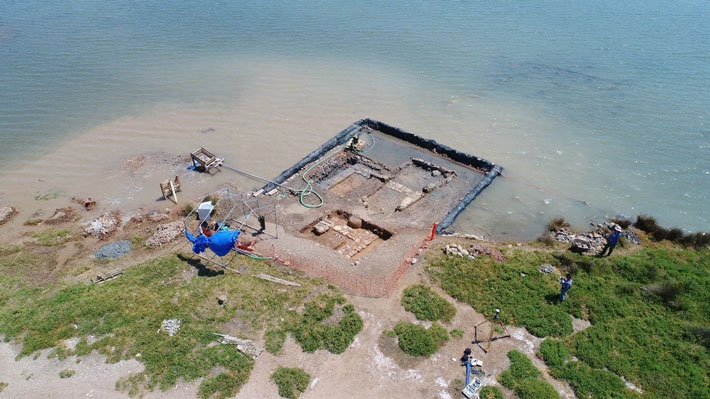 ATHENS, GREECE—Traces of a stoa, or covered walkway, have been found off the coast of the Greek island of Salamis, according to a Live Science report. Researchers from Greece’s Ministry of Culture and Sports said that the identification of the stoa will help them to study the topography and organization of the ancient city, which was described by the second-century A.D. geographer Pausanias. “There are still the remains of a marketplace, a temple of Ajax, and his statue in ebony,” he wrote. The section of surviving stones measures about 20 feet wide and 105 feet long. Archaeologists think the walkway once surrounded six or seven rooms. In one of the rooms, they found a storage pit measuring about 15 feet square. Amphora stoppers and bronze coins found in the stoa’s foundations suggest that the structure could date back to the fourth century B.C. Researchers also recovered a fragment of a marble stela bearing a relief depicting a bearded man being crowned by someone with a muscular right hand. Scholars suggest the hand may be part of an image of the hero Ajax. A fragment of a marble column bearing an inscription was also recovered. To read about excavations of a stoa in an ancient Greek sanctuary on a northern Aegean island, go to "Secret Rites of Samothrace."
ATHENS, GREECE—Traces of a stoa, or covered walkway, have been found off the coast of the Greek island of Salamis, according to a Live Science report. Researchers from Greece’s Ministry of Culture and Sports said that the identification of the stoa will help them to study the topography and organization of the ancient city, which was described by the second-century A.D. geographer Pausanias. “There are still the remains of a marketplace, a temple of Ajax, and his statue in ebony,” he wrote. The section of surviving stones measures about 20 feet wide and 105 feet long. Archaeologists think the walkway once surrounded six or seven rooms. In one of the rooms, they found a storage pit measuring about 15 feet square. Amphora stoppers and bronze coins found in the stoa’s foundations suggest that the structure could date back to the fourth century B.C. Researchers also recovered a fragment of a marble stela bearing a relief depicting a bearded man being crowned by someone with a muscular right hand. Scholars suggest the hand may be part of an image of the hero Ajax. A fragment of a marble column bearing an inscription was also recovered. To read about excavations of a stoa in an ancient Greek sanctuary on a northern Aegean island, go to "Secret Rites of Samothrace."
Possible Ancient Public Building Found Off the Coast of Greece
